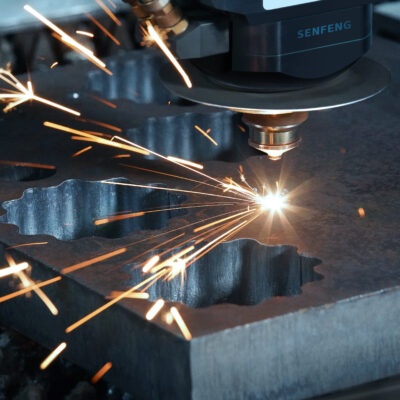Fiber laser cutter is revolutionizing the metal fabrication industry, offering high precision, efficiency, and versatility. For U.S. manufacturers and job shops looking to stay competitive, importing a fiber laser cutter—especially from China—can be a cost-effective solution. This guide will walk you through everything you need to know, from machine selection to customs clearance, to help you make a smart and compliant purchase.
Ⅰ. Why U.S. Businesses Are Importing Fiber Laser Cutter
- Lower Costs with Comparable Quality
Chinese fiber laser cutting machines, for example, often come at 30–50% lower prices compared to American or European brands, while still meeting industry standards. Companies like SENFENG and HSG offer robust models with international certifications (e.g., CE, FDA-compliant laser modules).
- Wide Range of Models and Features
Fiber laser cutter manufacturers provide machines with various power outputs (1.5kW, 2kW,3kW to 20kW, 30kW, 60kW and 80kW), working areas (e.g., 1500×3000mm), and automatic loading/unloading systems—ideal for customizing based on your specific needs.
Ⅱ. Key Considerations Before Importinga Fiber Laser Cutter
- Define Your Cutting Needs
Ask yourself:
Are you using it yourself or resell the machine?
What materials and thicknesses will you cut?
What thickness and sample pieces do you usually cut?
How many hours per day will the machine operate?
Is there any technician who can operate the machine?
Do you need sheet, tube, or dual-purpose cutting?
The answers will determine the required laser power, bed size, service and automation level.
- Choose the Right Manufacturer
Look for:
Export experience (especially to the U.S.)
Has this manufacturer participated in metal fabrication exhibitions in the United States, such as Fabtech?
Is it available in the US?
After-sales service (local technicians, remote support, spare parts)
Certifications (e.g.FDA compliance)
Warranty and training support
Tip: Request video demonstrations, customer references, and factory audit reports.
- Understand the Total Cost of Ownership
Beyond the machine price, consider:
Shipping and import duties
Installation and training
Maintenance and consumables (nozzles, lenses, protective windows)
Ⅲ. U.S. Import Regulations You Must Know
- Tariffs and HS Code
Most fiber laser cutters are classified under HS code 8456.10. As of 2025, tariffs may apply depending on trade policies (e.g., Section 301 tariffs on Chinese goods).
- Required Documentation
You will need:
Commercial invoice
Packing list
Bill of lading
Certificate of origin
FDA compliance declaration (for laser safety)
- Customs Clearance Process
Work with a licensed U.S. customs broker to:
Classify the machine properly
Calculate and pay the correct duties
Avoid clearance delays
Pro tip: Ask your supplier to handle DDP (Delivered Duty Paid) shipping if you prefer hassle-free delivery.
- Shipping Options and Lead Time
Common Methods
FCL (Full Container Load): Most common for large machines.
LCL (Less than Container Load): Ideal for small or low-volume imports.
Air Freight: Fast but costly—used for urgent spare parts or samples.
- Typical Timeline
From factory to your U.S. facility: 4 to 8 weeks, depending on the manufacturer’s production schedule and port conditions.
- Ensuring After-Sales Support in the U.S.
Local Service Centers and Technicians
Ask whether the brand has U.S. offices or partner distributors. Companies like SENFENG USA, for example, have local warehouses and service teams in California and Chicago.
- Remote Support and Spare Parts
Make sure the supplier provides:
24/7 remote troubleshooting
Easy ordering of consumables
Online training materials and manuals
- Avoiding Common Pitfalls
Don’t choose solely by price – ultra-low prices may signal lack of quality or support.
Avoid unknown suppliers with no reviews or export records.
Check compatibility with U.S. voltage and safety standards (208V/3-phase or 480V systems).
Ⅳ. Conclusion: Is Importing a Fiber Laser Cutter Worth It?
Importing a fiber laser cutter from China or other countries can save you tens of thousands of dollars—if done right. By carefully choosing a reputable supplier, understanding import regulations, and preparing for post-installation support, U.S. businesses can enjoy world-class equipment at a fraction of the cost.
Ⅴ. FAQs
How much does it cost to import a fiber laser cutter to the U.S.?
Prices range from $60,000 to $200,000+ depending on specs. Add 10–30% for shipping and setup. However, in 2025, the United States has substantially raised tariffs on Chinese imports, with specific rates varying based on current trade policies.
Do I need FDA approval for a laser machine?
Yes.
Can I finance an imported laser cutter?
Yes. Some U.S. banks or equipment financing companies may support imported machines with proper documentation.
Who are the top 5 fiber laser cutter manufacturers in China?
1.Hans laser
2.Senfeng laser
3.Bodor laser
4.HSG laser
5.Gweike laser
These five companies have been exporting laser machines to the United States for many years and have established U.S. branches to offer localized support. You can compare their products and pricing to find the best fit for your needs. If you want to learn more details, just contact SENFENG.
